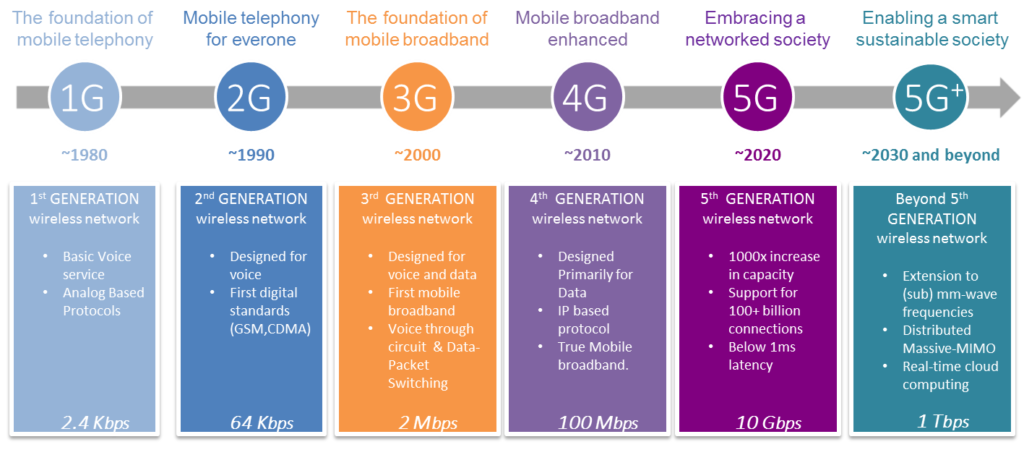Emerging information technologies will require a major increase in data-rates and capacity of wireless communication systems. Our society is on the brink of a new age with the development of new visionary concepts such as internet of things, smart cities, autonomous driving and smart mobility. This stimulates the use of the millimetre-wave (mm-wave) frequency domain to support these new concepts, where much more signal bandwidth is available. The rapid increase in data-rates is illustrated in the figure below, showing the roadmap towards beyond 5G, i.e. 5G+. For 5G, the objective is to achieve data-rates up to 10 Gbit/s through the use of the lower mm-wave spectrum (<40 GHz). For beyond 5G, even higher frequencies well above 100 GHz are expected. Especially the power consumption of the radio electronics and robust communication links to mobile users remain major challenges.

At mm-wave frequencies, reconfigurable multi-antenna systems with a vast amount of highly integrated antennas are necessary in order to overcome the large path loss between base-station and mobile user equipment (UE). Due to the much larger number of antenna elements on the base-station as compared to the UE, concepts such as centralised Massive-MIMO (multiple-input-multiple-output) become feasible, which is an essential building block for the anticipated data-rates and system capacities. However, since mm-wave frequencies suffer from high free-space path loss and are highly sensitive to blockage caused by buildings and objects, many of those base-stations are needed to effectively cover an area. Due to the high complexity and relatively poor energy efficiency of current mm-wave radios and digital processing units, the cost and power consumption of such a solution is high, hampering the acceptance of this technology. Moreover, for moving users this concept suffers from a large signal overhead due to user hand-overs between base-stations, reducing the net data-rates users will experience. To overcome these issues, major breakthroughs are needed. In times where there is already a lack of experts in the European telecommunications industry, this need requires an urgent demand for training multidisciplinary early-stage researchers (ESRs) to achieve and maintain European leadership in this multi-disciplinary field. Via research training we aim to develop robust and energy-efficient mm-wave communications concepts for 5G+. Furthermore, we will equip the ESRs with transferable skills relevant for innovation and long-term employability.
The figure below shows two typical mm-wave base-station solutions. In this figure on the left, a central base-station is used to serve all UEs within a small cell as described above. This concept is known as centralised Massive-MIMO. On the right, instead of a central base-station unit, a much larger cell is covered by multiple low-cost remote radio heads (RRHs), which are all connected via front-haul links to a central processing unit. This concept is known as a cloud radio access network (C-RAN). The main purpose of such a distributed base-station is to make it possible that several RRHs can communicate with the UEs. By doing so, the robustness of mm-wave links is drastically improved as at least one RRH maintains line-of-sight (LOS) contact to the UE. Moreover, overhead due to hand-overs of moving users is significantly reduced as a large area is managed by one central processing unit. Due to the use of distributed RRHs, this concept is referred to as Distributed Massive-MIMO (DM-MIMO). In order to cope with changing channel conditions, dynamic (re-)configuration of the clusters is necessary, which in turn requires system calibration and synchronisation techniques to be in place. Moreover, due to the vast amount of mm-wave antennas and amplifiers, the cost and energy efficiency of the RRH’s has to be minimised, contributing to the goal of minimising the overall power consumption of 5G and beyond.

Based on the experience of the current 5G R&D efforts, the new specialists require a strong multi-disciplinary background, including mm-wave electronics, mm-wave antennas and signal processing. State-of-the-art university education programmes do teach the necessary disciplines, of course, but today each of them constitutes a separate specialisation track. However, the highly integrated nature of mm-wave base-stations demands the integration of all those disciplines into a single specialisation programme.
The MyWave network consists of leading technology and system providers as well as top ranking academic institutions and will offer a multi-disciplinary and cross-sectoral doctoral training programme. This is achieved by combining the expertise and best practises in the area of mm-wave antennas, mm-wave electronics and signal processing. This will give Europe a head-start in this area and will result in excellent employment opportunities for the ESRs within the EU high-tech sector.
